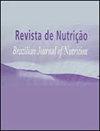巴西东北部某首都的青少年、成年人和老年人的超加工食品消费和人体测量指标
IF 0.5
4区 医学
Q4 NUTRITION & DIETETICS
Revista De Nutricao-brazilian Journal of Nutrition
Pub Date : 2022-01-01
DOI:10.1590/1678-9865202235e210052
引用次数: 1
摘要
【摘要】目的评价青少年、成人和老年人超加工食品的消费及其与人体测量指标的关系。方法横断面、户籍、以人口为基础的研究,包括10-19岁的青少年、20-59岁的成年人和60岁及以上的老年人,特雷西纳市城区居民,Piauí。收集了人口统计、社会经济、生活方式、食物消费和人体测量数据。方差分析检验与Bonferroni事后检验以及95%置信区间(95% CI)的粗线性和调整线性回归一起使用。采用显著性水平为5%。结果在成人和老年人中,超加工食品的摄入量与人体测量变量之间无显著相关性。然而,在青少年中,结果显示出负相关,从而表明人体测量指标随着超加工食品消费量的增加而减少。结论超加工食品的食用量与成人和老年人的人体测量指标无相关性;然而,在青少年中,结果显示出负相关,这鼓励了新研究的发展,特别是纵向研究。本文章由计算机程序翻译,如有差异,请以英文原文为准。
Consumption of ultra-processed foods and anthropometric indicators in adolescents, adults, and the elderly in a capital city in northeastern Brazil
ABSTRACT Objective To evaluate the consumption of ultra-processed foods and associate it with anthropometric indicators in adolescents, adults, and the elderly. Methods Cross-sectional, domiciliary, population-based study, comprising adolescents aged 10-19 years, adults aged 20-59 years, and elderly people aged 60 or older, residents of the urban area of the city of Teresina, Piauí. Demographic, socioeconomic, lifestyle, food consumption, and anthropometric data were collected. The analysis of variance test was used along with the Bonferroni post-hoc test and crude and adjusted linear regression with a 95% confidence interval (95% CI). The level of significance adopted was 5%. Results There was no significant association between the consumption of ultra-processed foods and anthropometric variables in adults and the elderly. However, among adolescents, the results showed an inverse association, thus signaling a reduction in anthropometric indicators as the consumption of ultra-processed foods increases. Conclusion There was no association between the consumption of ultra-processed foods and anthropometric indicators in adults and the elderly; however, among adolescents, the results showed an inverse association, which encourages the development of new studies, especially longitudinal ones.
求助全文
通过发布文献求助,成功后即可免费获取论文全文。
去求助
来源期刊
CiteScore
1.20
自引率
12.50%
发文量
24
审稿时长
6-12 weeks
期刊介绍:
Revista de Nutrição is former Revista de Nutrição da Puccamp, founded in 1988. It is a bimonthly publication every four months and it is of responsibility of the Centro de Ciências da Vida, da Pontifícia Universidade Católica de Campinas . It publishes articles that contribute to the study of Nutrition in its many sub-areas and interfaces; and is open to contributions of the national and international scientific communities.

 求助内容:
求助内容: 应助结果提醒方式:
应助结果提醒方式:


